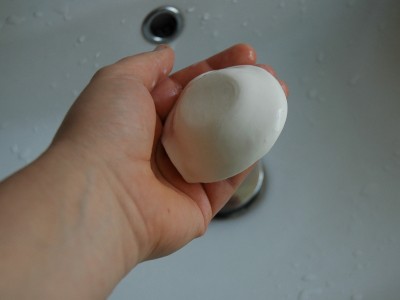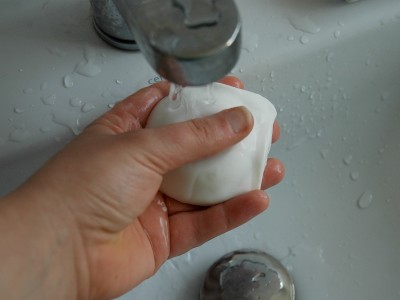Using our 100% vegetable oil soap
You may remember a few months ago I spent a bajillion hours waiting for some 100% olive oil soap to reach trace then, as a glutton for punishment, I decided to make a second batch of another 100% vegetable oil soap the same day.
We started using the 100% olive oil soap and have got through a few small bars of it – John likes it a lot. He likes that it doesn’t lather much (as it, conversely, encourages him to use less of it) and it doesn’t smell perfumed either (he hates perfumed things).
In a “why change what’s working?” way, we hadn’t tried the other set of soap – the 100% veg oils one – but I decided that should change this week!
The non-lye ingredients of the 100% olive oil one are pretty obvious – the 100% veg oil one a little more complicated — but still, everything bought from the supermarket. I used Frugal Queen’s recipe and method – olive oil, sunflower oil and Cookeen (solid veg shortening) – just leaving out the scent. It traced faster than the olive oil one thankfully!
The resulting soap is softer than the 100% olive oil one (apparently that’s down to the veg shortening) and not quite as pale – a soft lemon-ish colour. (It had some soap ash on it when I first picked it out of its drying place, which I’ve mostly scrapped off – hence the not-perfectly-smooth edges and slight colour variation on the before use picture above). It lathers quite a bit more than the olive oil soap – not crazy commercial soap levels but noticeably more. It did feel more like shop bought soap though – leaving my skin feeling a little “squeaky”. That’s not necessarily a bad thing, just a thing.
I spent £5.27 on the ingredients (£1.89 on the olive oil [on offer at Netto at the time], £1.06 on the sunflower oil, £1.43 on the shortener and £0.89 for the caustic soda needed for this recipe – based on a 500g bottle from Wilkinsons; and I used tap water and no scent) – which I think out frugals the Frugal Queen ;) I ended up with 2850g of finished soap – the bars were randomly sized but if they were normal 100g-ish bars, that would be about 19p a bar (or about 24p a bar if they’re 125g, which was the weight I used to work out the per-bar cost of the 100% olive oil ones [35p]).
As I said regarding the 100% olive oil ones, I’m not sure I enjoyed the process enough to do it often but I like the idea of making a big batch every six months/year as necessary. Before the next batch though, I’m going to try handmilling some of the ones from this batch to try out different (frugal, supermarket-sourced) scents – and might try turning a bar into liquid soap too as that’s handy when my hands are filthy from gardening.
Has anyone else made the Frugal Queen’s 100% veg oil soap? What did you think of it? Or do you have any 100% supermarket-sourced veg oil soaps? Or suggestions for frugal scents and any handmilling/liquid-soap-from-bar making advice?
Read MoreUsing our homemade olive oil soap
Last week, we started using our homemade olive oil soap.
You might remember I spent A MILLION HOURS waiting for the damn thing to trace back in February but didn’t think it would work because it was sloppy in the moulds for a few days. Then it started to solidify and I did a happy dance.
So, anyway, after a few more weeks of curing/drying, we started using it last week. I went with one of the 100% olive oil ones, not the one-third olive oil, two-thirds other veg oils (more on those later when we try them).
I was really paranoid at first – worried it would be too caustic or something – so made sure to scrap off the bits of white powder (soda ash) from the edges, rather than just washing it off. Cavitch’s troubleshooting guide says to beware of “excessive” white powder as that can indicate too much lye or hard water has been used – but I don’t think my white powder was “excessive”, just some.
The soap is very pale – almost pure white. Apparently the better quality of olive oil, the paler the resulting soap. My olive oil (which came from Netto) claimed to be extra virgin so this fits. It has quite a neutral smell – slightly olive oil-ish but nowhere near as strong as the olive oil I started with. It’s pretty hard now and doesn’t lather much at all – but that’s expected with pure olive oil soap and the latter isn’t a huge problem as it’s not like we’ll be using it as shaving soap or anything like that.
So anyway, the verdict. It feels nice to use – smooth and silky, and no alkaline burns at all – always a good thing in a soap ;). Because of the play and stuff last week, I haven’t actually got my hands that dirty since we started using the soap so can’t comment on the actual cleaning properties but it leaves my skin feeling clean – and … not “squeaky”. I don’t know how to describe it but whenever I usually use normal bar soap, my skin feels “squeaky” afterwards – presumably either dryness or some sort of residue. That isn’t a problem with our olive oil soap – even when I washed them five times in a row to double-triple-quintiple check that it wasn’t too caustic (yes, really overly paranoid).
As I said explained in my last soap post, we’re not interested in pretty or pleasantly perfumed soaps – we want them to clean us, be long lasting, to have an inoffensive smell, create minimal waste and be frugal. The hardness of this soap means it doesn’t turn to mush in the soap dish and the only waste produced were two plastic bottles (which can be recycled – but one of which was actually reused as a soap mould first).
As for the frugalness, I had used this recipe and method which called for 1 litre of olive oil, 126g of caustic soda and 300g of water. I paid £2.52 for the olive oil from Netto, about £1.50 (I’ve lost the receipt!) for 500g of caustic soda from Wilkinsons (so about 38p for the amount I used) and tap water (which is effectively free), so the consumables cost around £2.90 for the batch. (I did buy a pan and steel dish to use too – but they’ll be used again for soap making and other non-foody pursuits (such as dyeing) so I considered them a general craft supply costs rather than including them in these figures.)
Weighing it just now, I’ve got around 1050g of dried, ready-to-use soap – or 35p per 125g bar — my bars differ in sizes (from about 50g, for the ones from the fruit tray mould – as seen in the pictures – to about 125g for ones shaped in an old mini roaster tray) but that’s the size of a bar of Oliva soap, which is the 100% olive oil soap we’d used previously, so is a good comparison. Oliva usually costs about £1 a bar.
All in all, I’m glad I tried it and I’m very happy with the result – but it was a bit of a faff. I think I did the right thing by processing two loads of soap on the same day so made economies of scale re: faffiness. Hopefully the soap we’ve got now will last us about a year – I’d happily do it once every six months or a year but I couldn’t be bothered doing it much more frequently than that.
Read More







